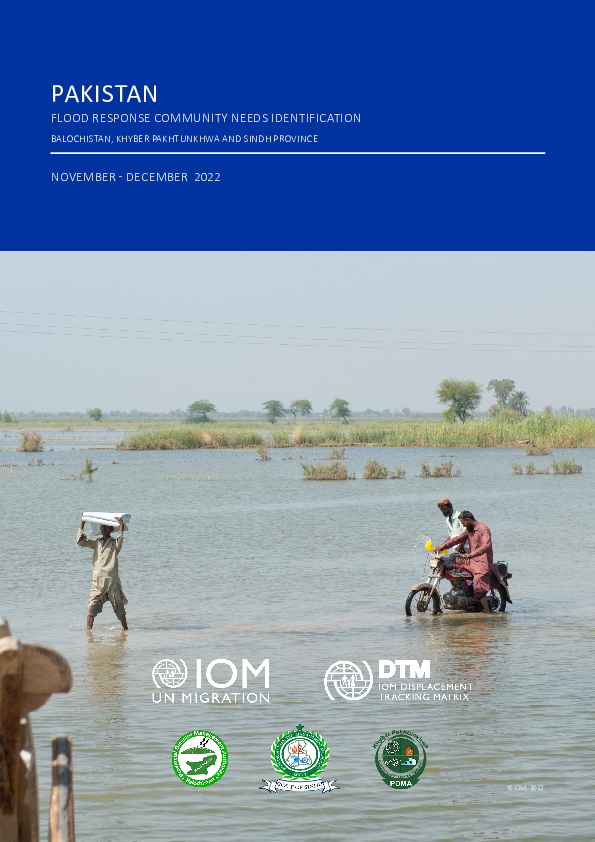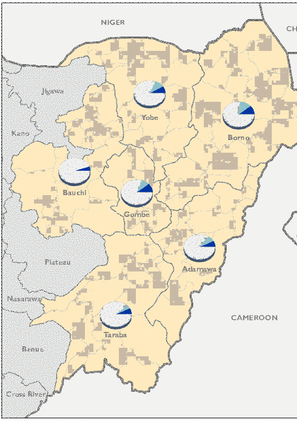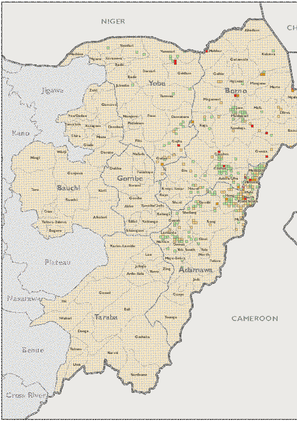-
Countries
-
Data and Analysis
-
Special Focus
-
Crisis Responses
Site Assessment
IDPs per period of displacement at the State level.
Distribution of IDPs by LGA.
Distribution of Return locations.
Distribution of IDP locations.
Estimated number of IDPs and Returnees by State.
Contact
DTM Libya, DTMLibya@iom.int
Language
English
Location
Libya
Snapshot Date
Mar 31 2023
Activity
- Mobility Tracking
- Site Assessment
Detention Centre Profiling is a component of IOM Libya’s Displacement Matrix programme. It is a data oriented tool that routinely provides specific sex and age demographic data and key sectorial information on individuals held in Libya’s detention centres on the date of assessment.
Contact
DTM Support, dtmsupport@iom.int
Location
Malawi
Activity
- Mobility Tracking
- Site Assessment
Period Covered
Mar 31 2023 -Apr 27 2023
The assessments were carried out following Tropical Cyclone Freddy, which hit the Southern region of Malawi on 12 March 2023 affecting at least 14 districts. The most affected districts are Blantyre, Chikwawa, Nsanje, Mulanje, Phalombe Zomba and Mangochi. Over 426,04 families had their shelters completely/partially destroyed as a result of flash floods and Landslide caused by TC Freddy, displacing over 500,000 individuals to at least 500 camp/collective sites.
Population Groups
Survey Methodology
Unit of Analysis Or Observation
Type of Survey or Assessment
Keywords
Geographical Scope
Administrative boundaries with available data
The current dataset covers the following administrative boundaries

Contact
dtmpakistan@iom.int
Language
English
Location
Pakistan
Period Covered
Nov 01 2022
Dec 31 2022
Activity
- Survey
- Mobility Tracking
- Site Assessment
Storms and heavy monsoon rains in Pakistan have caused widespread flooding and landslides across the country. According to the National Disaster Management Authority (NDMA), up to 33 million people have been affected by the floods since mid-June 2022 and a total of 90 districts have been labelled by the Government of Pakistan as ‘calamity-hit’, as of 18 November 2022. Besides that, more than two million houses are reported to be damaged across the country.
Given the number of calamity-hit districts and the number of affected people, IOM's Displacement Tracking Matrix (DTM) decided to roll out its Community Needs Identification (CNI). This was done following coordination and approval from the Provincial Disaster Management Authority (PDMA) of Balochistan, Khyber Pakhtunkhwa and Sindh. The purpose of the CNI is to understand the displacement situation and multi-sectoral needs of the affected population at the village level. IOM deployed its CNI across the 18 districts reporting the highest displacement in the provinces of Balochistan, Khyber Pakhtunkhwa and Sindh. The CNI was thus carried out across 7,211 flood-affected villages or villages that hosted temporary displaced persons (TDPs) that exist under these 18 targeted districts.

Contact
DTM Haiti, DTMHaiti@iom.int
Language
English
Location
Haiti
Period Covered
Feb 12 2023
Mar 16 2023
Activity
- Mobility Tracking
- Site Assessment
- Baseline Assessment
In recent years, widespread insecurity in the Port-Au-Prince Metropolitan Area (PAPMA) has led to the displacement of thousands of people. In order to regularly update authorities and other partners on the displacement situation in PAPMA and therefore inform response strategies for displaced persons and communities hosting them, the Haitian Directorate General for Civil Protection (DGPC) and the International Organization for Migration’s Displacement Tracking Matrix (DTM) launched in August 2022, periodic assessments of neighborhoods and sites hosting displaced populations. Data is collected through direct observations and interviews with key informants in the areas hosting displaced populations. Two updating exercises (rounds) have been conducted : Round 1 was conducted from June to August 2022, and Round 2 was conducted from October to November 2022.
This dashboard presents the key findings from the third updating exercise (Round 3), conducted between 14 February and 16 March 2023. Of the 429 neighborhoods in the PAPMA, 411 were assessed, representing a coverage of 96 percent. A total of 127,977 Internally Displaced Persons (IDPs) (28,415 households) were identified, of which 38 percent were living in spontaneous-sites and 62 percent in host communities. Compared to Round 2, overall, there was a decrease of 18 per cent in the number of IDPs, which can be explained by the fact that some IDPs have returned to their origins. Indeed, 45,864 returnees (former IDPs) were identified, of which 32 percent returned between the last quarter of 2022 and the first quarter of 2023
Pagination
- Previous page
- Page 27
- Next page





